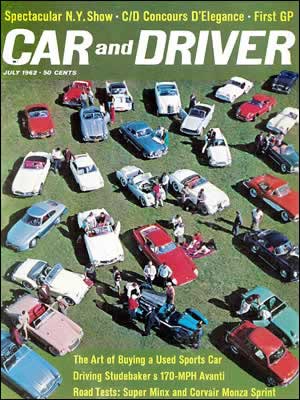
July 1962 Car and Driver cover.
July 1962 Car & Driver - Admiring the New Studebaker Avanti
Admiring the New Studebaker Avanti is the July 1962 review from Car and Driver. A crew from Studebaker took an R-2 out to Nevada for speed tests and ran a standing to a quarter mile in 60.8 seconds, hitting 107.10 mi. per hour with a 3.31-to-one axle ratio, making it indisputably the fastest genuine production car in America, if not the world. Though Sherwood Egbert has been president of Studebaker only since February 1961, he has extensively reorganized its management and supervised successful though superficial face-lifts on the Larks and Hawks. Now comes the Avanti. It is strictly an Egbert project, though the tale of his "creating" its design between Omaha and Denver on a jet flight to the west coast is belied by its strong resemblance to Loewy's own BMW 507 "Gunsight" coupe.
Like Ford's thunderbird, it will attract interest to its firm's full line of cars. Unlike it, the Avanti supplements the prestige with impressive handling, amazing performance, and boldly original styling. The Avanti was styled by Raymond Loewy, drawing heavily on experience from his 1957 BMW 507 prototype, and is a roomy 4-seater. The body is fiberglass, made by the Molded Fiberglass Body Company of Ashtabula, Ohio. A hundred contoured body parts are matched-metal die-molded and assembled with an additional 30 flat sections, the largest of which is the 126.5 in. long. Dry weight of the car is about 3,000 pounds. The Avanti is sensational for its appearance alone, and its performance places it in a class by itself. We were able to drive prototypes under development at the Studebaker proving grounds west of South Bend and found that the R-1 (unblown version) would accelerate from 0 to 60 in about eight seconds and hit 100 in about 18 seconds. We did not get any exact readings on the Paxton-supercharged R-2, but its potential is terrific.
Like Ford's thunderbird, it will attract interest to its firm's full line of cars. Unlike it, the Avanti supplements the prestige with impressive handling, amazing performance, and boldly original styling. The Avanti was styled by Raymond Loewy, drawing heavily on experience from his 1957 BMW 507 prototype, and is a roomy 4-seater. The body is fiberglass, made by the Molded Fiberglass Body Company of Ashtabula, Ohio. A hundred contoured body parts are matched-metal die-molded and assembled with an additional 30 flat sections, the largest of which is the 126.5 in. long. Dry weight of the car is about 3,000 pounds. The Avanti is sensational for its appearance alone, and its performance places it in a class by itself. We were able to drive prototypes under development at the Studebaker proving grounds west of South Bend and found that the R-1 (unblown version) would accelerate from 0 to 60 in about eight seconds and hit 100 in about 18 seconds. We did not get any exact readings on the Paxton-supercharged R-2, but its potential is terrific.
The car we drove had the 3.73-to-one ratio in combination with a Borg-Warner automatic transmission. Whether fitted with automatic transmission, or the three-and four-speed Warner gearboxes available, the lever is floor-mounted on a wide tunnel which also accommodates the hefty heater and ventilator controls. Light and wiper switches are above the gently curved windshield. The Studebaker Lark frame has been shortened and reinforced to carry the fiberglass body. There are anti-roll bars at both front and rear, and the semi-elliptic leaf springs have been supplemented by radius arms. The brake system includes Bendix-made Donlop disc brakes on the front wheels-the first American application on a production car since the early Chrysler and Crosley ventures of the 1950's. Stopping power is really impressive, aided by the large 6.7 x 15 tires. The car's handling, even though the suspension is soft enough to give the rear-seat passengers a comfort bubble ride, approaches sports-car standards. Body lean is almost non-existent, and although the power steering does not provide the road feel that most fast drivers might wish for, response is quick. The cam-and-single-lever steering gear gives three and a half turns of the wheel lock-to-lock. The seats are very comfortable, being padded to give lateral support, but adjustment is fore-and-aft only. On a long run, it would be advantageous to be able to vary the rake of the backrest. The steering wheel is mounted at an almost vertical angle, and has two spokes in current Studebaker fashion. In spite of a 22-gallon fuel tank behind the rear seat, there is relatively generous luggage space.
